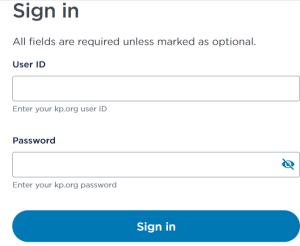The arrival of digital technology has completely changed how we get medical care, making it easier and more accessible than ever before. Kaiser Permanente is at the front of this change. As proof of their dedication to patient-centered care, they offer an online gateway to their patients. This guide goes into detail about the Kaiser Patient Portal, an important tool that makes it easier for patients and healthcare providers to talk to each other. This introduction is for both new and current users. It will go over the basics of how to access and use the portal, focusing on how important it is to modern healthcare management and how it gives people more control over their health journey.
| Article Name | Kaiser Patient Portal |
|---|---|
| Official Website | https://mydoctor.kaiserpermanente.org/ |
| Helpline Number | 877-240-1433 |
| Technical Support please contact | 1-888-901-4636 |
Kaiser Patient Portal Login
- Check out the official website :Visit Kaiser Permanente’s site.
- Get to the Patient Portal by: There should be a link or tab that says “Patient Portal,” “Member Sign On,” or something similar.
- Type in your login information: Enter your username and password on the page where you sign in.
If this is your first time using the site, you may need to make an account by verifying your personal and health insurance details.

- If it’s available, two-factor authentication: You might be asked to go through a two-factor authentication method for extra safety. Usually, you’ll get a code on the phone or email you used to sign up, which you’ll need to enter on the website.
- Get to Your Account: After logging in, you can see your medical information, make appointments, send messages to healthcare providers, and keep track of your prescriptions, among other things.
Kaiser Patient Portal Login Forgot Password
- Visit the Sign-In Page: First, go to the webpage for Kaiser Permanente.
Find the Patient Portal entry page and click on it. - Find the link that says “Forgot Password”: Find a link or button that says “Forgot Password” or “Reset Password” on the page where you log in.
- Check Your Identity: Click on the link that says “Forgot Password?”
You will be asked to enter your username or some other way to identify yourself, like your registered email address or member ID. - Just do what it says: After you’ve entered all the required information, just follow the on-screen directions.
Kaiser Permanente might give you a link to reset your password or a temporary password to the email address you used to sign up. - Look at your email: Look through your email for a message from Kaiser Permanente.
Check your spam or junk files if you can’t find the email. - Change Your Password: You can either click on the link in the email or use the temporary password to get in.
After that, you’ll be asked to make a new password.
Follow any password rules that Kaiser Permanente gives you to make sure your new password is strong and unique. - Use the new password to log in: Go back to the Patient Portal login page after you have changed your password.
Use your username and the new password to get in.
Kaiser Social Media Page
Facebook :- https://www.facebook.com/kpthrive
Instagram :- https://instagram.com/kaiserpermanente
Twitter :- https://twitter.com/kpthrive
Youtube :- http://www.youtube.com/user/kaiserpermanenteorg
pinterest :- https://www.pinterest.com/kpthrive
Conclusion
The Kaiser Patient Portal is a shining example of modern healthcare because it makes controlling your own health so much easier and faster. The portal gives people more control over their health by making it easier for them to do things like make appointments, get refills on prescriptions, and talk directly with their doctors. Personal health information is kept safe and easy to access thanks to a user-friendly design and strong security measures like the password recovery process. As healthcare changes in the digital age, tools like the Kaiser Patient Portal are essential for making people more involved, aware, and proactive in managing their own health.
Follow more for all patient portal information – Patientportal.online